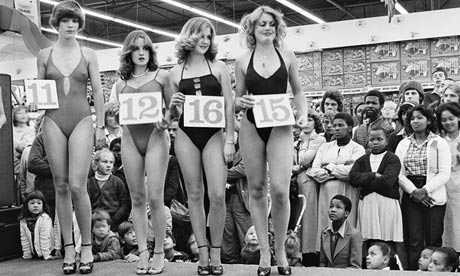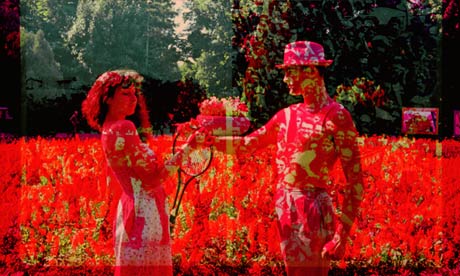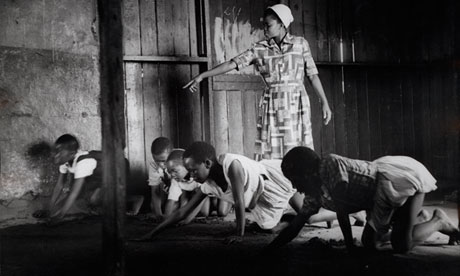
David Goldblatt's
Saturday morning at the Hypermarket: semi-final of the Miss Lovely Legs
competition, 1979-1980. Photograph: Courtesy of the photographer and
Goodman Gallery, Johannesburg.
Everything Was Moving: Photography from the 60s and 70s at the Barbican in London was the most ambitious and rewarding photography exhibition
this year. It showed how documentary photographers captured the social
and political upheavals of the 60s – the Vietnam war and global street
protest, the American civil rights struggle, the invisibility of
indigenous people and traditions. But it also explored how others, such
as Boris Mikhailov and Sigmar Polke, reacted to the playfulness of 60s artists such as Ed Ruscha and Andy Warhol by embracing conceptual art themselves.
 Boris Mikhailov's Superimpositions, late 1960s, from the series,
Yesterday's Sandwich. Photograph: Courtesy of Galerie Barbara Weiss,
Berlin
Boris Mikhailov's Superimpositions, late 1960s, from the series,
Yesterday's Sandwich. Photograph: Courtesy of Galerie Barbara Weiss,
Berlin
 Boris Mikhailov's Superimpositions, late 1960s, from the series,
Yesterday's Sandwich. Photograph: Courtesy of Galerie Barbara Weiss,
Berlin
Boris Mikhailov's Superimpositions, late 1960s, from the series,
Yesterday's Sandwich. Photograph: Courtesy of Galerie Barbara Weiss,
Berlin
It began with Bruce Davidson and William Eggleston, both of whom photographed tensions in the American south. In
black and white, Davidson chronicled the civil rights movement in the
deep south and the inner-city ghettoes of New York and Chicago,
while Eggleston turned his outsider's eye on the riven world around him,
most notably in Memphis, Tennessee and Greenwood, Mississippi. His use
of colour saturation that borrowed from advertising, and the odd angles
he chose, transformed the everyday into something threatening and
unfamiliar.
 Black South African schoolgirls re-smearing the floor of the shack
they have lessons in with cow-dung so it is not too dusty on Sunday,
when it is used for church services. [New Age, 25 January 1962].
Courtesy of the Hasselblad Foundation, Gothenburg, Sweden © The Ernest
Cole Family Trust
Black South African schoolgirls re-smearing the floor of the shack
they have lessons in with cow-dung so it is not too dusty on Sunday,
when it is used for church services. [New Age, 25 January 1962].
Courtesy of the Hasselblad Foundation, Gothenburg, Sweden © The Ernest
Cole Family Trust
 Black South African schoolgirls re-smearing the floor of the shack
they have lessons in with cow-dung so it is not too dusty on Sunday,
when it is used for church services. [New Age, 25 January 1962].
Courtesy of the Hasselblad Foundation, Gothenburg, Sweden © The Ernest
Cole Family Trust
Black South African schoolgirls re-smearing the floor of the shack
they have lessons in with cow-dung so it is not too dusty on Sunday,
when it is used for church services. [New Age, 25 January 1962].
Courtesy of the Hasselblad Foundation, Gothenburg, Sweden © The Ernest
Cole Family Trust
The stark contrasts continued with images of apartheid-era South Africa by David Goldblatt and the lesser-known black photographer Ernest Cole.
Cole defied apartheid laws – becoming reclassified as "coloured" rather
than "black", which meant he could travel without a work permit – and
made provocative series across the country, about crime (pickpockets at
work on the streets) or the endemic injustice of a system in which young
girls were schooled in subservience. Works by this pioneer of South
African reportage, who died unsung and in poverty in New York just a
week after Nelson Mandela was released from prison, were the highlight
of the show.
Upstairs at the Barbican, things took a turn towards the conceptual with Polke's smeared, stained black-and-white images of a staged fight in an Afghan village between a bear and two dogs, a metaphor for Russian imperialism. Stranger still was Mikhailov's project, Yesterday's Sandwich (1968-1975) – a dark satire on Soviet censorship.
If, like me, you had only seen Larry Burrow's Vietnam war photography in books and magazines, the giant colour prints were by turns moving and shocking. This was up-close and visceral reportage from the white heat of battle.
It was almost a relief to come upon Li Zhensheng's vast panoramic collages of demos and mass rallies in Mao's China, but their scale only served to unsettle even more. Against all this turmoil, Malike Sidibe's playful studio portraits of young Africans in thrall to the music and style of black American pop culture provided some much-needed breathing space. It was that sort of show: almost as exhausting as it was edifying, and maybe even too ambitious – but there was something for everyone.
Upstairs at the Barbican, things took a turn towards the conceptual with Polke's smeared, stained black-and-white images of a staged fight in an Afghan village between a bear and two dogs, a metaphor for Russian imperialism. Stranger still was Mikhailov's project, Yesterday's Sandwich (1968-1975) – a dark satire on Soviet censorship.
If, like me, you had only seen Larry Burrow's Vietnam war photography in books and magazines, the giant colour prints were by turns moving and shocking. This was up-close and visceral reportage from the white heat of battle.
It was almost a relief to come upon Li Zhensheng's vast panoramic collages of demos and mass rallies in Mao's China, but their scale only served to unsettle even more. Against all this turmoil, Malike Sidibe's playful studio portraits of young Africans in thrall to the music and style of black American pop culture provided some much-needed breathing space. It was that sort of show: almost as exhausting as it was edifying, and maybe even too ambitious – but there was something for everyone.
No comments:
Post a Comment